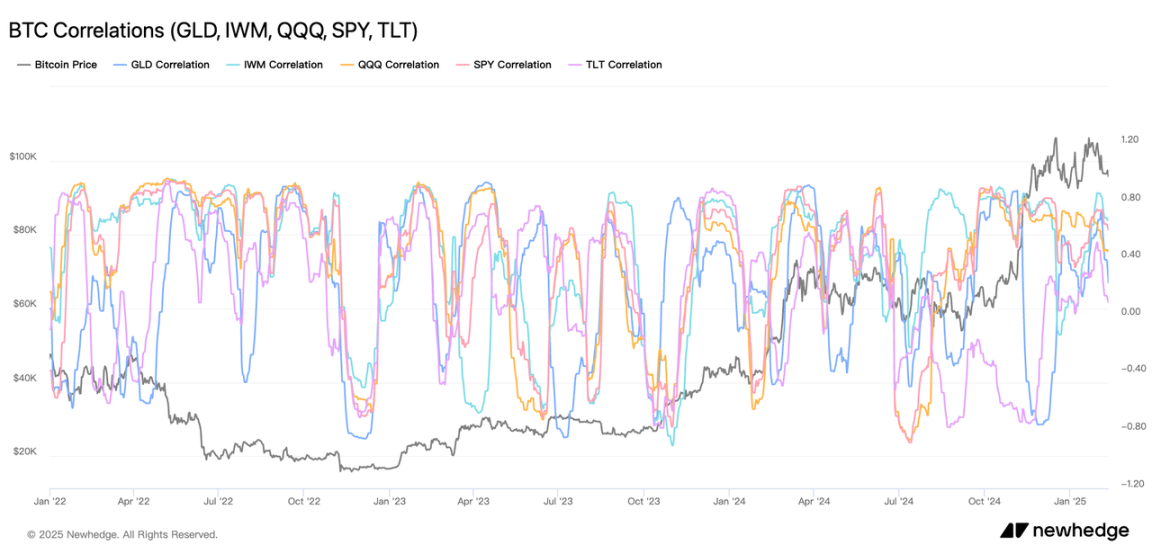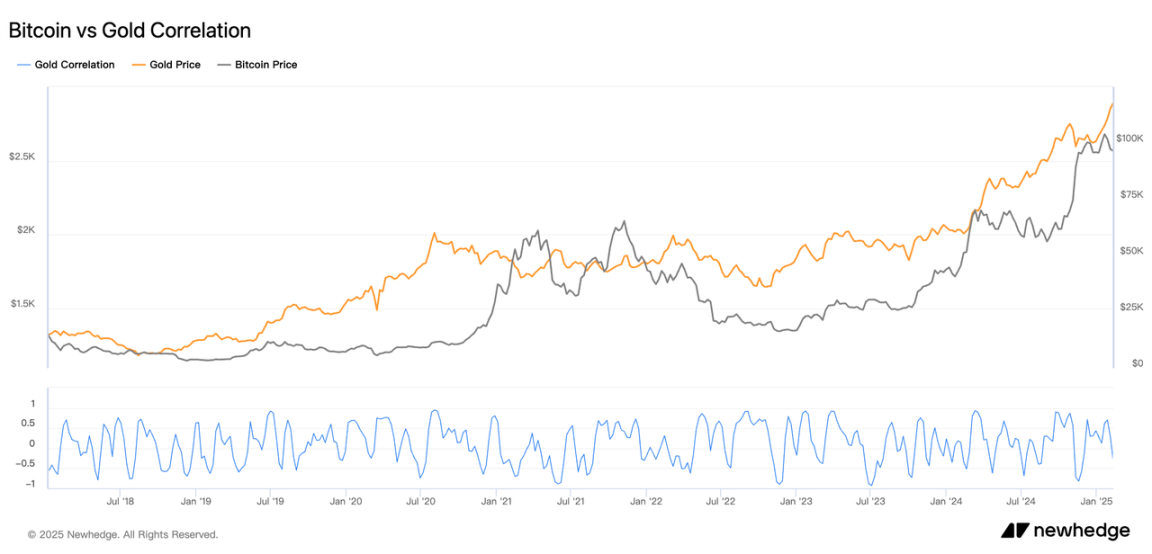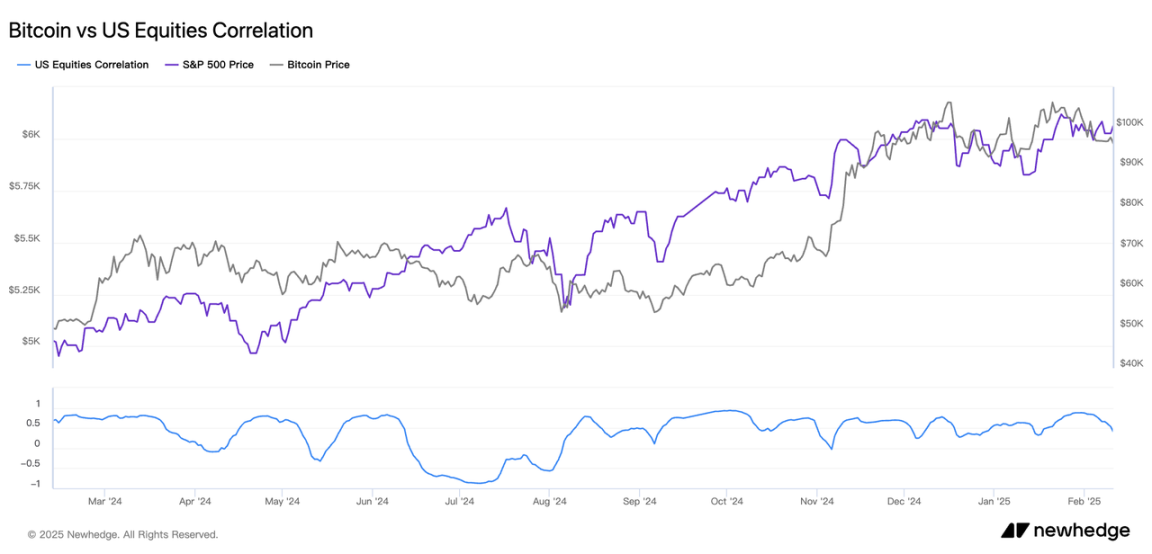Is Bitcoin a “risk-hedging hybrid” independent of the traditional system, or has it gradually been incorporated into the pricing framework of mainstream assets?
Author: ChandlerZ, Foresight News
At the beginning of 2025, the global capital market is in a two-star situation. Recently, spot gold prices have repeatedly broken new highs. As of February 16, COMEX gold futures prices once surged to US$2968/ounce, with the largest increase during the year being nearly 10%, just one step away from the US$3000 mark.
After Bitcoin broke through the high of US$100,000, it continued to fluctuate in the range of US$9,000 to US$110,000. The fatigue during the year was contrary to its status as a new safe-haven asset. This fluctuation not only exposes the current logical differences in the pricing of the two types of assets, but also points to the recalibration of risk scales by global capital in the “Trump 2.0 era.”
Bitcoin VS Gold: From a safe-haven narrative to functional differentiation
The linkage evolution of Bitcoin, U.S. stocks and gold is essentially a drift process of identity perception in the process of its financialization. Measured by the correlation coefficient between Bitcoin and traditional assets, its correlation shows significant dynamic changes.

As a traditional safe-haven asset, gold has a relatively complex relationship with Bitcoin. Judging from long-term data, the correlation between Bitcoin and gold shows obvious instability, frequently fluctuating between positive and negative ranges. In the early days, the correlation coefficients between the two were mostly negative correlated. At that time, Bitcoin was regarded as a “digital substitute” for gold. However, in the market turmoil after 2022, the two have appeared in sync many times. In late 2024, the correlation tends to be positive, but fluctuations are still significant.
This contradiction stems from the difference in attributes between the two: gold’s hedging function relies on its physical attributes and historical consensus, while Bitcoin’s digital gold narrative relies more on market sentiment and technical expectations. When Bitcoin hits a record high in 2021, the price of gold is at a periodic trough. Starting in 2024, the two countries will each rise simultaneously due to factors such as the central bank’s gold purchase wave and the approval of Bitcoin ETFs. It can be seen that the correlation between the two is driven by periodic events rather than the inevitable connection of intrinsic value logic.

The linkage of U.S. stocks and the double helix structure under the siphon of liquidity
In terms of U.S. stocks, Bitcoin is often classified as a “risky asset”, and its price trend shows a significant positive correlation with the technology-dominated Nasdaq index. This correlation will peak in 2021, with the two simultaneously hitting historical highs and then correcting back, and simultaneously bottomed out at the end of 2022, showing the consistency of market behavior driven by risk appetite.
The correlation between Bitcoin and the S & P 500 index shows a relatively mild positive correlation. The correlation coefficient remains between 0 and 0.5 most of the time. Bitcoin’s increase is significantly greater than that of the S & P 500, and price synergy is clearer in the high point area. This relationship was particularly evident in late 2024, when risky assets generally received a boost as expectations of the Fed’s shift to a dovish stance rose.
During the period when the Federal Reserve signaled interest rate cuts, this synergy even exceeded the negative correlation between traditional technology stocks and bonds. The strength of the correlation between the two has exceeded the cluster effect between traditional technology stocks, suggesting that cryptocurrency is systematically embedded in the growth stock valuation system. However, it is worth noting that this positive correlation shows significant asymmetry: during the market downward cycle, the correlation coefficient between Bitcoin and U.S. stocks is not high, revealing its excess risk premium characteristics in the context of high volatility.

This phenomenon can be explained from the perspective of market psychology and liquidity. When global economic expectations are improving, investors ‘risk appetite increases, and funds flood into U.S. stocks and Bitcoin at the same time; and when market risk aversion heats up, both may be under pressure. QUICK FactSet data shows that the total market value of dollar-denominated stocks around the world has increased by US$13.6 trillion from the end of 2023 to US$121.8 trillion. Bitcoin has increased by more than 150% over the same period, confirming the joint promotion of loose liquidity and risk appetite. However, the high valuation of U.S. stocks also implies a correction risk. If the stock market corrects, Bitcoin may face simultaneous pressure, and gold may benefit from safe-haven demand.
Reshaping financial attributes
The linkage changes between Bitcoin, U.S. stocks and gold reflect the structural changes of participants in the crypto market. In the early days, Bitcoin was mainly held by retail investors and geek communities, and its price was independent of the traditional financial system. But after 2020, the intervention of institutional investors accelerated its financialization process, making it more susceptible to U.S. stock sentiment. The growth in open interest in bitcoin futures on the Chicago Mercantile Exchange (CME) further strengthens this path. In addition, institutional variables such as the U.S. SEC’s approval of Bitcoin spot ETFs and differences in regulatory policies among various countries have also had a long-term impact on Bitcoin’s asset attribute positioning.
The high volatility of Bitcoin after breaking through a historical high of US$100,000 stems from the interaction of multiple market forces. On the one hand, early investors gradually cashed in profits at high levels, while new funds brought by institutional channels such as ETFs formed a strong undertaking. This change in power between buyers and sellers caused prices to fluctuate violently within the range.
On the other hand, the current market is still in the gestation period of loose expectations, and large-scale water release has not yet been substantively launched. The market is mainly rotated by existing funds between different prices. The lack of sustained incremental funds entering the market also limits the upward momentum after breaking through new highs. At the same time, the use of leveraged instruments such as futures and perpetual contracts is more active. High leverage amplifies price fluctuations, and frequent forced liquidations further aggravate market fluctuations.
But overall, the reflexivity of technological innovation is also breeding new possibilities. Currently, Bitcoin is being included in the asset-liability management framework of sovereign wealth funds. Appropriate allocation of crypto assets can improve tail risk defense capabilities while maintaining a stable Sharp rate. This functional evolution indicates that the correlation between encrypted assets and traditional assets will present a more complex hierarchical structure, fluctuate as risky assets during macro stability periods, release non-linear associations during systemic crises, and ultimately develop independent asset category positioning.
In the myth of Noah’s Ark, clean creatures come in pairs, and unclean creatures go alone. The dilemma of the correlation between Bitcoin and traditional assets is like a “financial monster” that cannot find companions in the flood of digital civilization. Perhaps this lack of correlation is what it is. It does not require benchmarking against thousand-year hard currency or accompanying the technology bubble, but redefines the value coordinate as a heterogeneous asset native to the blockchain.



